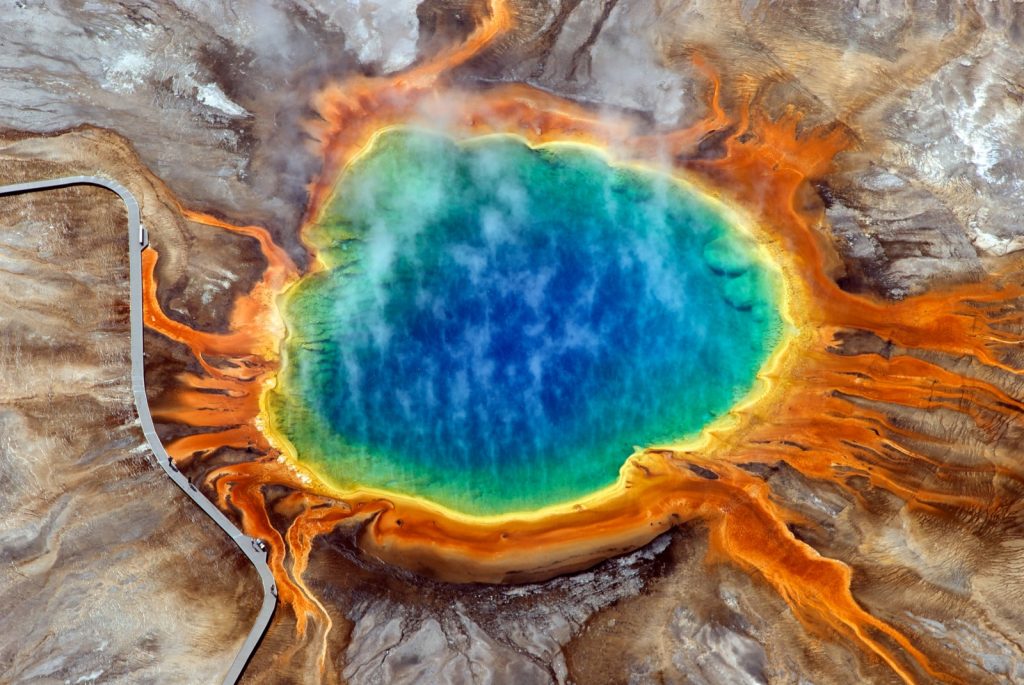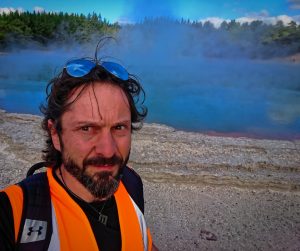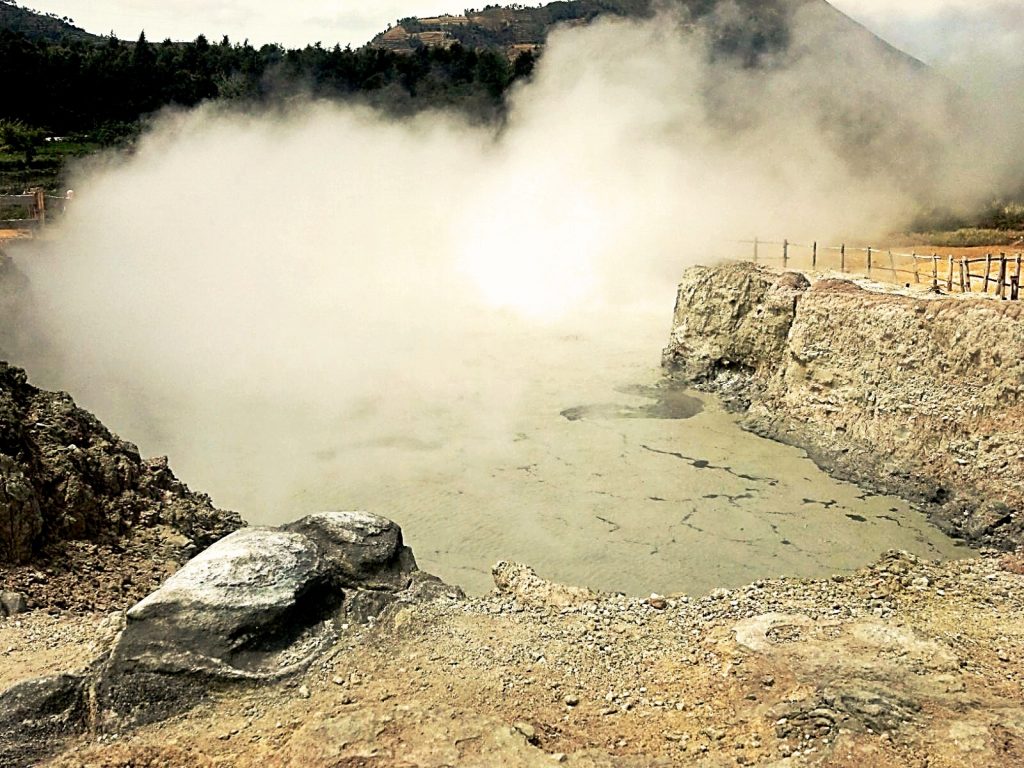
Photo 1. Yellowstone National Park. The Grand Prismatic Spring is the largest hot spring in the United States, and the third largest in the world. Photo credit: David Mencin (distributed via imaggeo.egu.eu)
Volcanic eruptions are among the fascinating natural phenomena we can observe on Earth. Along with being very attractive, they are hazardous for both society and infrastructures. Eruptive styles are various and today we focus our attention on one particular type of explosive event: hydrothermal eruptions. We have interviewed Cristian Montanaro on the topic.

Photo 2. Cristian in front of the Champagne Pool part of the Waiotapu geothermal area in the North Island of New Zealand. Photo credit: Cristian Montanaro
Dr. Cristian Montanaro is an experimental and field volcanologist currently working at the University of Auckland. He obtained his PhD at Ludwig-Maximilians-Universität Munich in 2016 focusing on the understanding of the physical processes of steam-driven explosive phenomena. His research interests thus focus on hydrothermal eruptions, in particular on the role of the host environment properties (lithology, alteration degree, tectonic context) in controlling these steam-driven eruption’s dynamic and potential violence.
What is the main characteristic of hydrothermal eruptions?
Hydrothermal eruptions are peculiar for being produced by the near-instantaneous vaporization of pressurized hot water (and steam) within the pores and cracks of a “host rock”, and they do not result from any input of mass or energy directly derived from magma. The sudden decompression results in the flashing of liquid water to steam, that blasts the enclosing rock apart and ejects it upward and outward. Generally, the water flashing or gas-release may be triggered by a rapid decrease in pressure (e.g. seismic-produced fractures, lake drainage, landslides, etc.), but to produce eruptions are required forces great enough to fragment and eject the enclosing rock. In this, the temperature-pressure conditions and amount of initial fluids (mostly water) control how much thermal energy -or fuel- is available to be converted into mechanical force for these eruptions. On the other hand, the energy partitioning in terms of rock fragmentation and clast-ejection energy depends largely on the rock porosity, permeability, and strength. Altogether, these controlling factors determine the hydrothermal eruption violence and its dynamic. In addition, hydrothermal eruptions are very variable. They can last from seconds to hours and produce craters spanning from a few meters up to more than 2 km in diameter! More? Produced craters depth may range from few to several hundred meters strongly depending on the host rock composition, and the ejected clasts may have a velocity of few tens of m/s up to more than 200 m/s.
Where can we find volcanoes producing hydrothermal eruptions?
Hydrothermal eruptions are very common in broad areas of active and dormant volcanic terrains, where high heat-flow, combined with shallow ground-water close to its boiling temperature, favours the rapid generation of steam and fluid-pressure build-up. So we can say that many volcanoes or volcanic environments around the world can be affected by this type of eruptions. Hydrothermal eruption craters can indeed be found in Iceland (Kverkfjöll caldera), New Zealand (Wai-o-tapu geothermal field), Indonesia (Dieng geothermal field, photo 3), Japan (Ontake volcano), Greece (Nysiros caldera), Central America (El Salvador volcano), and United States (Yellowstone caldera, photo 1), and elsewhere.

Sulphur fumes from 2000 m a.s.l of Dieng Plateau, Indonesia. Photo credit: Erwin Prastowo (distributed via imaggeo.egu.eu)
What is the hazard related to this type of volcanic activity? Are hydrothermal eruptions more hazardous than other types of explosive activities?
Hydrothermal eruptions are in general destructive local events which remain unpredictable in terms of timing and magnitude. Additionally, they may be highly energetic and produce extended ash plumes, pyroclastic density currents, and widespread ballistic events. The latter two, in particular, may represent a major hazard within 1–3 km of the eruptive area. Hazards from hydrothermal eruptions were globally highlighted at Ontake in Japan in 2014 when an unheralded explosion killed 65 hikers. In New Zealand, a similar eruption from Te Maari crater pelted 0.5 m-diameter boulders onto the iconic Tongariro Crossing and Ketetahi Hut in 2012. Only the midnight occurrence prevented loss of lives. Overall, hydrothermal hazard is definitely more hazardous than their magmatic counterpart, due to the high frequency of these events (>200 over the last three centuries causing thousands of deaths), and to the fact that they occur in active geothermal areas that often host renewable power-generation facilities (e.g., Wairakei in NZ, or Krafla Power Plant in Iceland), major touristic sites (e.g. Wai-o-tapu in NZ, Yellowstone in US), and urban areas (e.g., Pozzuoli in Italy, or Rotorua in NZ).
What is the current state of the art on hydrothermal eruptions? How are researchers investigating this type of explosive events?
Despite their frequent occurrence, these eruptions are still poorly understood. In many cases, the incomplete stratigraphic records, together with the partial understanding of the driving physical processes, and the fact that eruptions are often preceded by very short time frames of unrest which are difficult to interpret (e.g. as geophysical and geochemical signals), is making such eruptions very hard to study. However, in the last years of investigation, there have been field geological observations, as well as geophysical and geochemical monitoring data feeding a large number of studies, from physical modelling to laboratory experiments and numerical simulations. As result, light has been shed on key factors controlling eruption violence, trigger mechanisms and dynamic, thus helping to improve hazard assessment and modelling of hydrothermal eruptions in hydrothermally active environments. But we are not lowering our guard! More is in the cauldron, and new methodology (e.g. mapping the evolution of geothermal feature, and high-resolution electric resistivity investigation of shallow part of geothermal areas) are now applied, that could lead to innovations in the monitoring and warning of explosive hazards at monitored geothermal fields.
